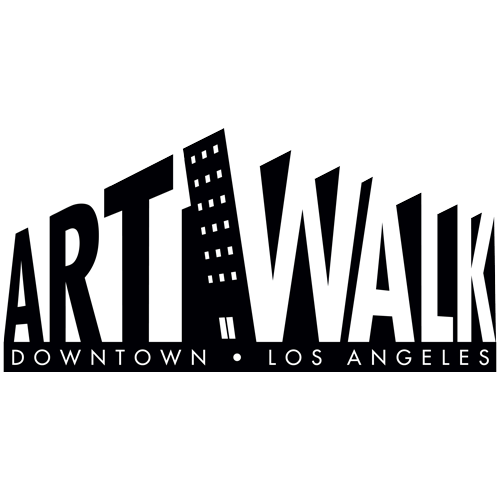It was a hot, dog-days-of-summer afternoon when I rolled out of Pershing Square subway station in Downtown Los Angeles and looked up to discover Angelus, the in-progress and reputed “largest mural in the world by one artist.” It was the rendezvous point for my first meeting with the artist himself, Robert Vargas. But the long stretch of metal scaffolding hanging from the 14-story building was empty.
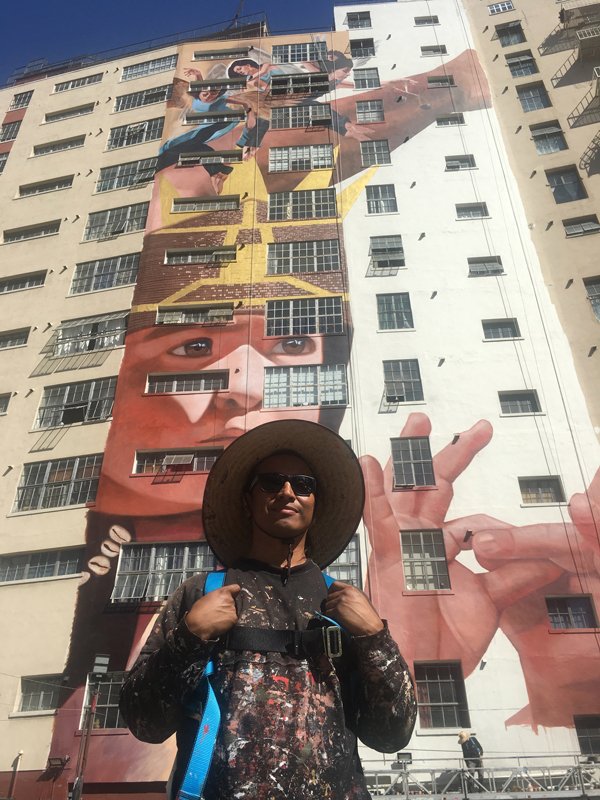
I shielded my eyes from the blazing sun bouncing off the wall’s massive, colorful figures and spotted walking toward me a man in a black long-sleeved sweatshirt and pants splattered with paint. He was wearing straps and a wide-brimmed straw hat, Vargas’s signature mural-mode headgear that I’d seen in photos. Not a hard hat, I thought. This is physical, potentially dangerous work. Either this man is courting risk and fame, or he’s a gifted artist with a mission. Both, perhaps?
“This mural is a celebration of the multicultural diversity and inclusion of Los Angeles that I appreciate and love so much,” Vargas explains as we sit down to talk. “I want people from all walks of life to feel like there’s something in it for them. With the right message, the right location at the right time, a mural can transcend a community.”
The Pershing Square location, he says, is key. “It’s ground zero for every march and protest that comes through here. It’s the first thing that many people see when they’re visiting Los Angeles. They come here for a summer concert, or to see the arts, or the Downtown Art Walk.”
The title Angelus he says, loosely references the idea of a call to prayer. “There’s a whole narrative that goes behind this mural that also connects it to that prayer mantra. When you look at the mural there’s this whole legacy. It’s a kind of legacy mural for the city.”
Vargas says he’s planning to finish the mural by next spring. In total, it will reach across more that 60,000 square feet. So far, he’s done about one third, and includes the face and hands of a child; part of a thick, muscled arm; and three angels.
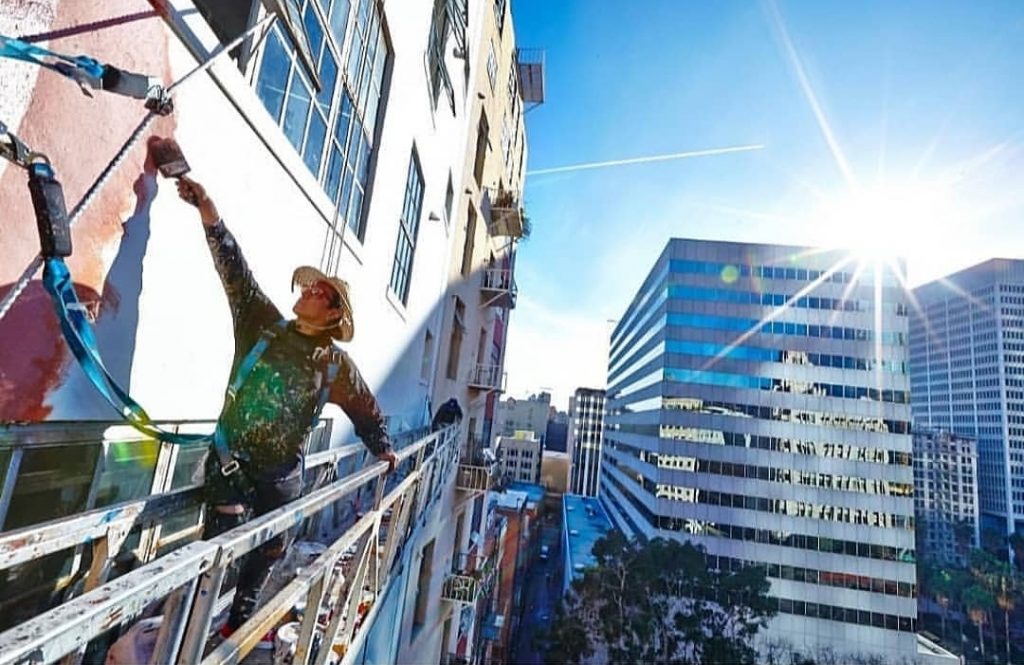
One of the angels, he explains, is an African American homeless woman who modeled for him, and often sits nearby at the Pershing Square intersection. For another angel, the gender is not defined. “Angels are not typically painted to look like a person of color. And when I think about angels, I don’t know if they’re male or female. So, this was another opportunity to open up the discussion and awareness for the gender-fluid, nonconforming community.” I ask about the scales of justice the angel is holding. “These are now the scales of equality,” he answers firmly.
The third angel, above the rest, is his mother. He credits her with introducing him to Downtown where she worked for many years. “I am sixth-generation Angeleno and grew up in Boyle Heights in an 1892 Victorian home on the street called City View. I had a clear sightline to the Downtown skyline.” Historically, the district is known for its diversity, and has been home to Jewish, Japanese, Russian, Polish, and Mexican American immigrants. “Like the Ellis Island of the West,” he says, adding that he’s of Mexican and Native American descent.
The face of a four-year-old child is painted at the base and is the mural’s anchor he says. She represents the Tongva Indian Natives. “They were the original inhabitants of the Los Angeles basin, so they were the first Angelenos. Everything begins there.” Vargas reached out to a Tongva tribe and invited the tribal council chief to the mural site for a ceremony before the painting process began. “He blessed the wall and my hands. There was burning sage and blowing of the conchshell. It was really, really beautiful.”
The girl’s hands, shaped in American sign language, is another effort to widen the mural’s reach. “Rather than just appropriating the sign language, I reached out to the deaf community and was invited to Marlton School for deaf and hard of hearing children. I did a drawing demonstration to show how I communicate without sound and words. And together we came up with that sign to demonstrate relationship unity. It’s a sign for unity.”
The arm, he explains, was modeled by his friend Oscar De La Hoya, the Mexican American former professional boxing champion. “He was part of the Olympic committee that was instrumental in bringing the Olympics back to Los Angeles in 2028. He also comes from my neighborhood.”
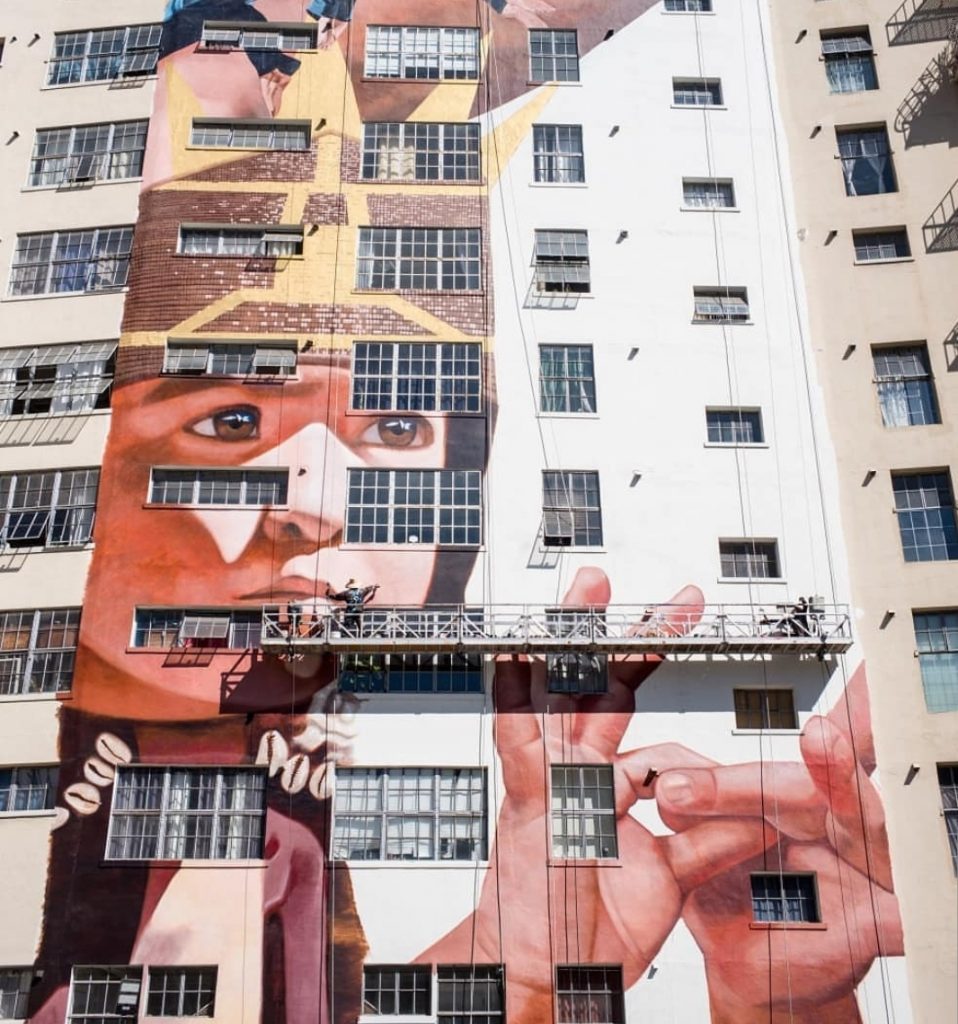
Vargas studied the wall for four years before he began the mural to see how sunlight and shadows move across it. February 9th, he determined, is the apex point of that combination. He is using this date as his guide for coloring and shadowing the work. He likens it to the spring equinox in Teotihuacán near Mexico City when the ancient pyramids there are believed to hold special energy that can be passed to people at the site.
“I use just one brush,” he explains as I ogle his diminutive equipment. “All of my work is freehand. I don’t use any grids or projections.” He’ll use his phone, rather than paper, to help him reference certain points. “I scale it in my head. I come up on the lift and I figure that right about here is where I want to be, and then I start painting.” On his phone, he shows me a photo of himself in scale to the building while he’s working on the scaffold. My jaw drops. He is a barely visible speck compared with the monumental size of his muraled figures.
Even as a child, Vargas was a proficient painter. “I’ve been painting murals since I was about 10. My first mural at a museum was at the Autry Museum [in Griffith Park, Los Angeles] when I was 16.” He went on to study art at the Pratt Institute in Brooklyn, New York. And while his murals are now seen by a wide variety of international audiences, his studio paintings and black and white portraits remain the bulk of his work.
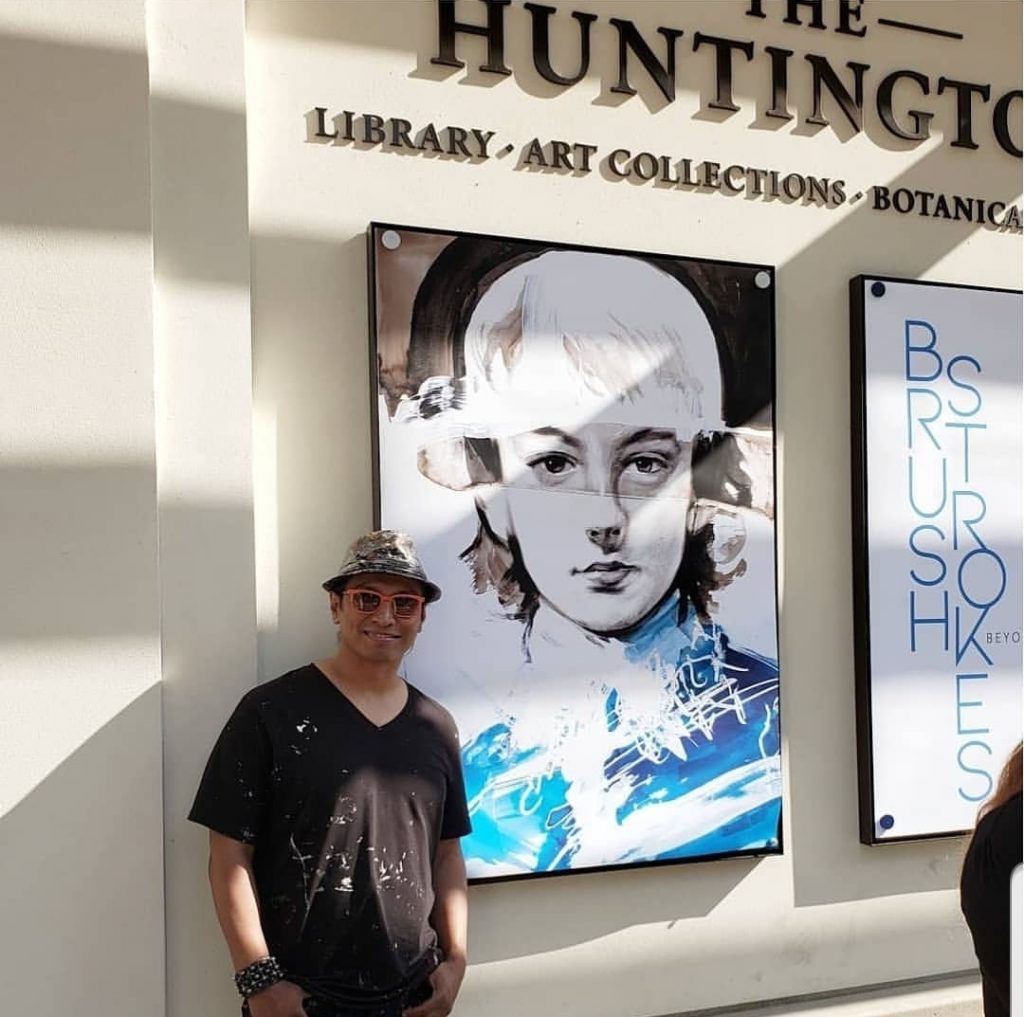
He currently has a solo show in Sweden at the Vida Museum with 23 paintings through November. The opening, he says, was the museum’s most successful turnout to date.
He began his live, on the sidewalk, black and white portraits as a way to reach people who would normally not venture into an art gallery. “The dilemma I recall was, ‘How do we get people to Downtown to see art?’ I was showing at several galleries at the time and thought, ‘Why don’t I open up my process and go outside the galleries?’ Accessibility to the arts is hugely important for me. That’s why I paint at Downtown Art Walk.

From 2005, he became a fixture of the monthly Downtown Los Angeles Art Walk. At the same time, he began his free Red Zebra events that he now organizes on a quarterly basis. “I’ve been bringing together designers, artists and performers that I’ve felt were Downtown-centric. Then inviting the city to become a part of it, and not charging a dime.” Vargas has been shouldering all the costs. “I’ve been doing this because I believe in the artists. There’s no one trying to profit on their need for exposure.”
As a Downtown Art Walk artist, he has since set up his ‘outdoor studio’ at Spring and 6th Streets under the powerful gaze of his iconic mural Our Lady of Downtown LA. He’ll paint about 15 black and white portraits on those evenings with subjects he chooses from among the growing crowd. His preferences are clear. “You don’t raise your hand, and you don’t say, ‘I’ve got X amount of money.’ It’s not about commerce. It’s about the exchange and being present, and all the drawings stay with me. They’re not for sale.”
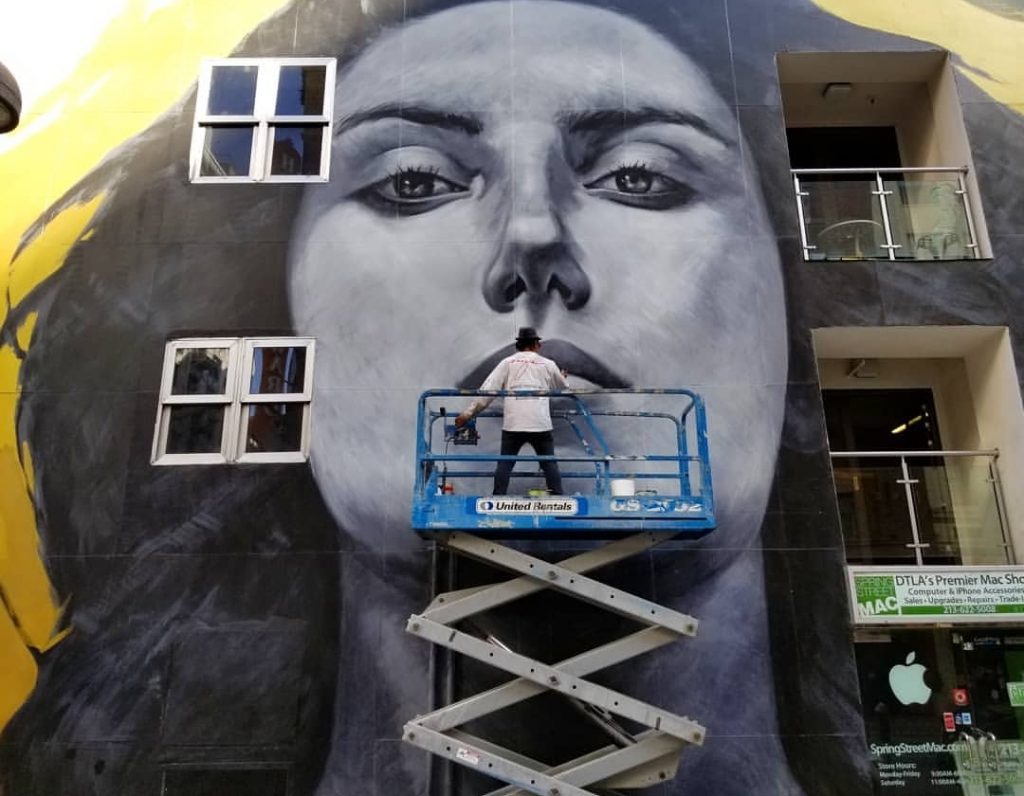
The black and white portraits became part of his Portraits of Los Angeles series. He’s now calling them Portraits of the World as he discovered opportunities to create them abroad. “Whether I’m in London, Paris, Dubai, Jerusalem, or Tokyo, the crowds are always there, and they are part of the series.”
In total, Vargas now paints about 800 black and white portraits a year at varying locations worldwide, and for a variety of clients. “Each one takes about 15 minutes to finish,” he confides. He’s now working on a book of these portraits. “To coincide with the book release, I’ll do a huge exhibition divided into countries and continents.”
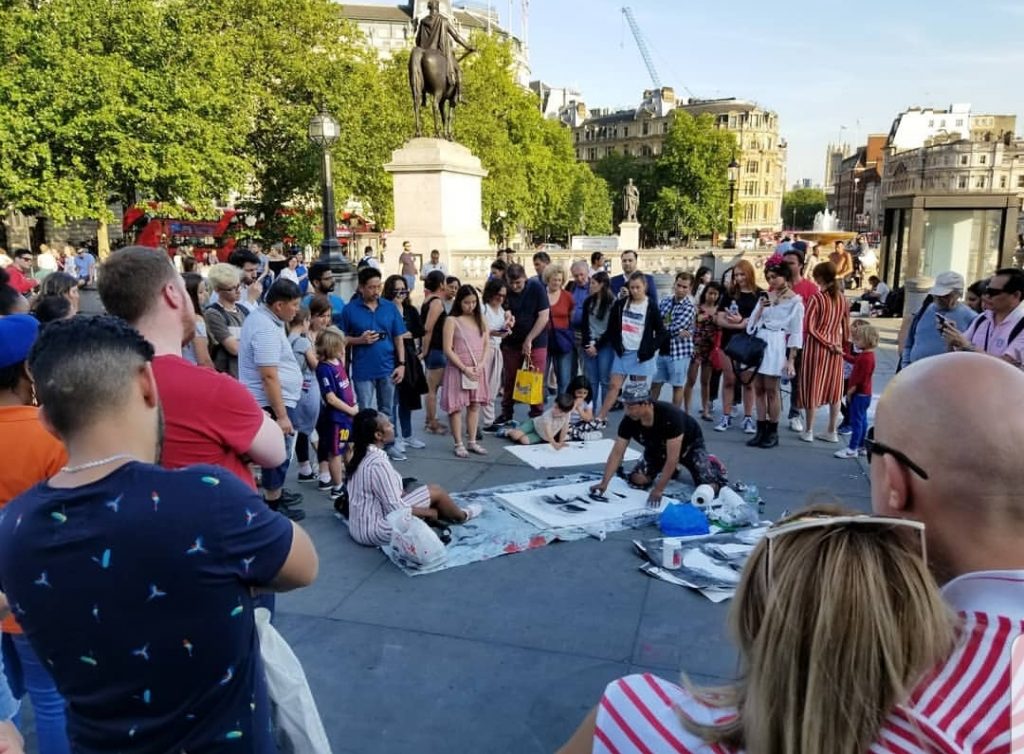
Among his clients, sponsors and growing fans he counts celebrities such as Snoop Dog, Kurt Russel and Goldie Hawn, Johnny Depp, and Nikki Sixx of Mötley Crüe. He became fast friends with Robbie Krieger and John Densmore of The Doors when he recently painted a mural of the original four band members across LA’s famed Whiskey a Go Go, a first for the storied nightclub. “I also do brand collaborations with sponsors from Lucas Films to Paramount Pictures. And I have a mural at Rockefeller Center right now where I collaborated with NBC to reimagine their peacock logo.”
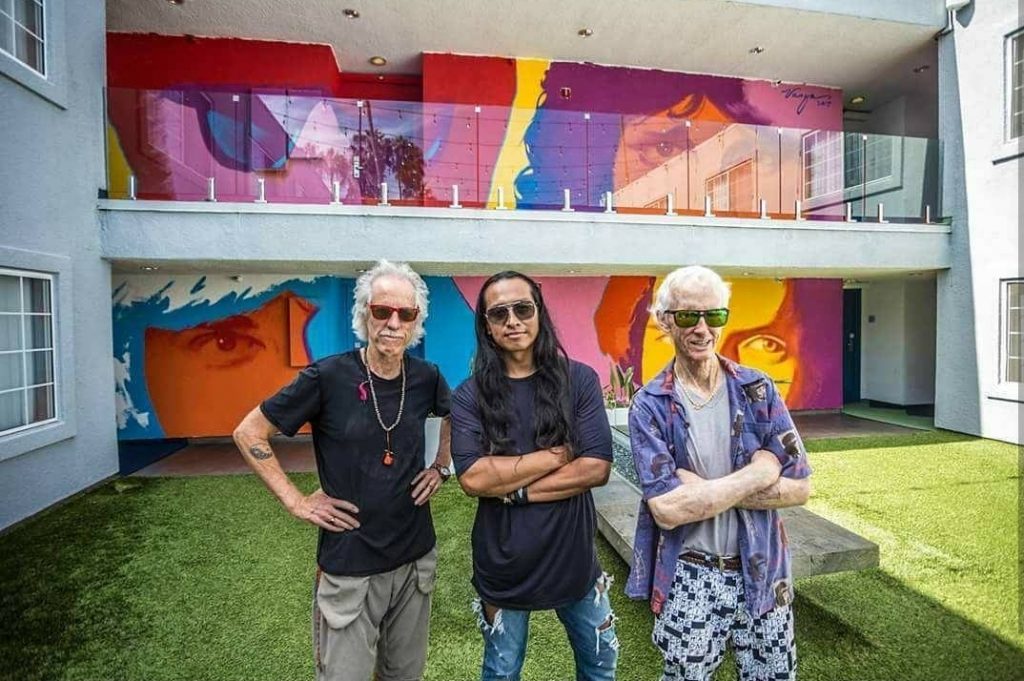
When we turn the conversation back to Los Angeles his face lights up. “I believe that Los Angeles is experiencing it’s creative golden age, not just in visual art, but in music, in fashion, in performance where we are establishing ourselves as an art capital. I find that a lot of established brands are relocating here because of the energy. And when you have that cross-pollination with homegrown talent you get a really interesting mix of creative output that’s quintessentially Los Angeles. It’s an exciting thing to be a part of. I’m excited to be a part of that conversation.” He quickly adds, “With my murals, I hope to further reclaim our status as a mural capital of the world.”
+++++++++++++++++++
Written by: Lucy Birmingham
Featured image by: Lucy Birmingham
All other images courtesy of Robert Vargas.
Follow Robert Vargas on Instagram:
instagram.com/therobertvargas
